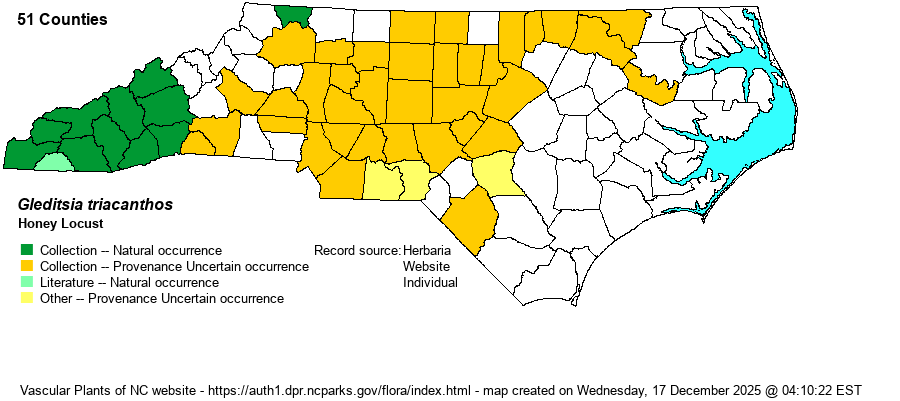| Author | L. | |
| Distribution | The native distribution of this species in the state is not clear. However, the species occurs throughout the Piedmont, is scattered in the Mountains, and occurs at scattered sites in the Coastal Plain but only in the western portions. There are numerous photos on iNaturalist from many counties not showing on the map; these are not mapped owing to uncertainty about the habitat. Weakley (2018) suggests that it is not native in NC east of the Mountains; Wikipedia suggests it is not native in NC at all.
This is a wide-ranging species but is primarily a tree of the central states and Midwest. It ranges east toward the Atlantic coast, but many records are of adventives or escapes there. It ranges west to the base of the Rockies. The native range certainly extends eastward to WV and eastern TN, if not western NC (where Weakley's map does show it as native).
| |
| Abundance | Fairly common in much of the Piedmont and the southern Mountains, but infrequent in the upper Coastal Plain and northern Mountains. The S4 State Rank refers to the total range and set of populations in the state; the abundance level of native populations, if any at all, is much more restricted. | |
| Habitat | This species favors rich soil of bottomland forests in its primary range, but it is often seen in pastures, fencerows, and other disturbed sites, though usually in rich to moist ground. Certainly, large individuals seen within bottomland forests, well away from fields and pastures, do not seem out of place or suggest an escaped species. However, in most counties it is more often seen along hedgerows or as scattered trees in pastures. |
| Phenology | Blooms in April and May; fruits from July to November. | |
| Identification | This is a medium-sized to occasionally large deciduous tree -– typically 50-80 feet tall, with many small leaflets (18-28) that are rather narrowly elliptic. There are usually long thorns on the branches, often reaching 2-3 inches long. The flower clusters are rather insignificant and dull greenish-yellow. However, the tree is often heavily adorned with exceedingly long and flat, dark brown pods that reach 8-12 inches long. Hardly any other plant in the state has such long flattened seed pods. Many people confuse this tree with Black Locust (Robinia pseudoacacia), but the latter species has fewer, wider, and more rounded leaflets, much shorter pods, much shorter thorns, and a conspicuous racemes of dangling white flowers. | |
| Taxonomic Comments | None, other than trying to establish the native range of the species, perhaps an impossibility.
| |
| Other Common Name(s) | Thorny Locust | |
| State Rank | S4 | |
| Global Rank | G5 | |
| State Status | | |
| US Status | | |
| USACE-agcp | FAC link |
| USACE-emp | FAC link |

